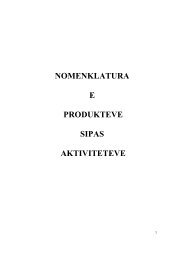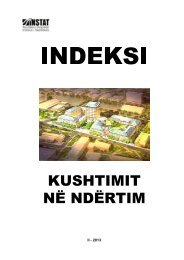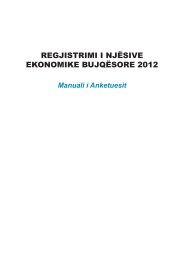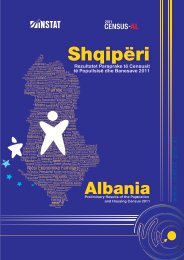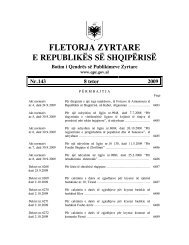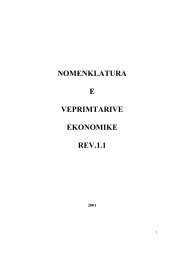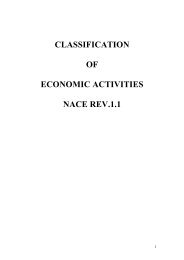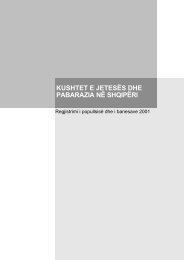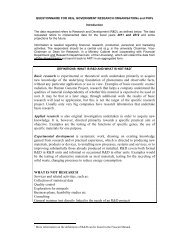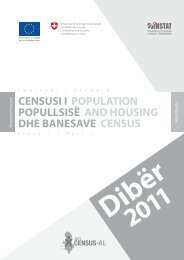Description of methods and sources for Albania - INSTAT
Description of methods and sources for Albania - INSTAT
Description of methods and sources for Albania - INSTAT
- No tags were found...
Create successful ePaper yourself
Turn your PDF publications into a flip-book with our unique Google optimized e-Paper software.
IPA 2009 Multi-beneficiary StatisticalCooperation Programmeexhaustively (6 128) enterprises or 11.6 percent <strong>of</strong> the sampling frame <strong>and</strong> thein<strong>for</strong>mation is collected by face to face interviews. Survey non response rate is 10.1percent according to the number <strong>of</strong> units.All cases <strong>of</strong> non-contact; full refuse <strong>and</strong> partial refuse (<strong>for</strong> different tables <strong>and</strong>indicators) are considered as non- response or missing data.The treatment <strong>of</strong> partial non-response is done by using direct <strong>methods</strong> or theircombinations such as study <strong>of</strong> time series data <strong>of</strong> enterprise <strong>and</strong> branch; data frombalance-sheet file (pr<strong>of</strong>it <strong>and</strong> loss accounts); the in<strong>for</strong>mation from other filesavailable in <strong>INSTAT</strong> such as business register, VAT file, file <strong>of</strong> production priceindex, average data <strong>of</strong> branch where the enterprise is included are analyzed <strong>and</strong> used,data from enterprises that have similar conditions are used <strong>and</strong> method <strong>of</strong> averagestructure, especially <strong>for</strong> expenditures, is usedImputation is done to cover the non-response <strong>of</strong> large enterprises. It is based on three<strong>methods</strong>: historical trend imputation <strong>for</strong> units with data from previous year in pr<strong>of</strong>it<strong>and</strong> loss account or in business register or in other surveys conducted by <strong>INSTAT</strong>;cold deck with use <strong>of</strong> the previous year administrative data <strong>for</strong> units <strong>for</strong> which wehave data from administrative <strong>sources</strong>; mean value imputation <strong>for</strong> the rest <strong>of</strong> theresponsive large enterprises in the respective stratum. For the part left untreated reweightinessmethod is used.Variables used <strong>for</strong> grossing-up to the population are the weights <strong>for</strong> the turnoverindex, based on the turnover from the SBS statistics <strong>for</strong> the reference year 2006Initial weight <strong>of</strong> enterprise in the stratum is estimated P (i) initial = Ni / niWhere: Ni is the total number <strong>of</strong> enterprises in the stratum ini is the number <strong>of</strong> sample enterprises in stratum iNote: For the purpose <strong>of</strong> GDP estimations only individual data <strong>for</strong> each enterpriseare used.Other statistical surveys (retail trade, producer’s price indices, construction costindex, consumers’ price index <strong>and</strong> short term survey) carried out by <strong>INSTAT</strong> are notused in calculation <strong>of</strong> indicators at current prices by production approach. Thesesurveys are used <strong>for</strong> calculation <strong>of</strong> indicators at constant prices (producer’s priceindices, construction cost index <strong>and</strong> consumers’ price index), quarterly indicators(short term survey) <strong>and</strong> indicators by expenditure approach (retail trade). Thesesurveys are mentioned in more details in next Chapters.34/236



